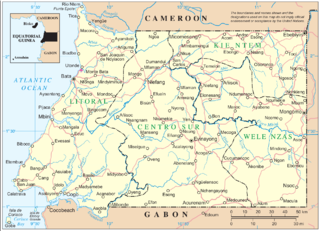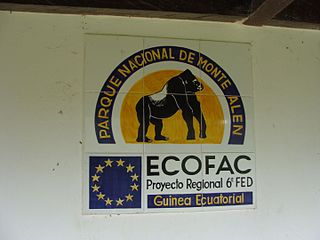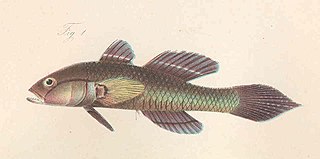
The Republic of Equatorial Guinea is located in west central Africa. Bioko Island lies about 40 kilometers (24.9 mi) from Cameroon. Annobón Island lies about 595 kilometres (370 mi) southwest of Bioko Island. The larger continental region of Río Muni lies between Cameroon and Gabon on the mainland; it includes the islands of Corisco, Elobey Grande, Elobey Chico, and adjacent islets. The total land area is 28,051 km2 (10,831 sq mi). It has an Exclusive Economic Zone of 303,509 km2 (117,185 sq mi).

Río Muni is the Continental Region of Equatorial Guinea, and comprises the mainland geographical region, covering 26,017 square kilometres (10,045 sq mi). The name is derived from the Muni River, along which the early Europeans had built the Muni River Settlements.

Mbini is a town in Río Muni, Equatorial Guinea, lying at the mouth of the Benito River. Mbini is the Ndowe name for Río Muni. It is located 44 km southwest of Bata.

Benitochromis is a small genus of cichlid fishes that are endemic to riverine and lake habitats in Middle Africa. Several of these species were originally assigned to the genus Chromidotilapia. The name of this genus is derived from the type locality of the Benito River in Equatorial Guinea compounded with chromis, a word which originated with Aristotle and which may derive from the Greek word chroemo, meaning "to neigh" and which may have originally referred to the drums of the family Sciaenidae and which was expanded to include cichlids, damselfishes, dottybacks and wrasses, groups of perch-like fish which were thought to be more closely related to each other than they are subsequent studies have apparently found them to be.

The Indonesian speckled carpetshark, Hemiscyllium freycineti, is a species of bamboo shark in the family Hemiscylliidae. It is found in the shallow ocean around the Raja Ampat Islands in West Papua, Indonesia, but was formerly believed to be more widespread. This was due to confusion with H. michaeli, a species described from eastern Papua New Guinea in 2010. Compared to that species, the spots on H. freycineti are smaller, more rounded or slightly elongated in shape, and tend to darken at regular intervals forming 8-9 vertical bars on the body and tail. Furthermore, the large black spot behind the pectoral fin is more clearly defined in H. michaeli than in H. freycineti. Confusingly, some books with illustrations and photos labelled as H. freycineti actually show H. michaeli.
Sclerophrys gracilipes is a species of toad in the family Bufonidae. It is found in southeastern Nigeria and east- and southward to southern Cameroon, Equatorial Guinea, Gabon, northern Republic of the Congo, and northern and northeastern Democratic Republic of the Congo. It is also likely to occur in southwestern Central African Republic and in the Cabinda Enclave of Angola. The holotype was collected from the Benito River in what was then French Congo. Common name French Congo toad has been coined for it.

The African wedgefish, guitarra, Lubbert's guitarfish, or spikenose wedgefish is a species of fish in the Rhinidae family. It is the only species in its genus to occur in the East Atlantic.
Entomacrodus cadenati is a species of fish in the family Blenniidae.
The glass blue-eye is a species of fish in the subfamily Pseudomugilinae. It is endemic to Papua New Guinea where it is only known to occur in a few small creeks adjacent to a 15–20 kilometres (9.3–12.4 mi) stretch of the Ok Tedi Mine supply road between the settlements of Kiunga and Tabubil in the Upper Fly River system close to the frontier with Irian Jaya. This species has a mainly transparent body with silvery gill covers and belly, there are black spots on the margins of the scales and there are black markings on the fins and lateral line, with the fins being shaded with yellow, with the exception of the transparent pectoral fins. It attains a standard length of 3 centimetres (1.2 in). This species was described by Gerald R. Allen in 1983 and its specific name honours the site biologist at the Ok Tedi Mine, David Balloch, for the support and assistance he gave Allen.
The Popondetta blue-eye or Popondetta rainbowfish, is a species of fish in the subfamily Pseudomugilinae. It is endemic to Papua New Guinea where it occurs at three localities around Popondetta in the east of the country. This species inhabits clear, fast flowing freshwater streams, although it has been reported from brackish water. This species was described in 1981 as Popondetta connieae by Gerald R. Allen from a typelocality of Auga Creek, about 5 kilometres (3.1 mi) south of Popondetta where Allen collected the 200 types along with Brian Parkinson. Allen gave it the specific name connieae to honour his wife, Connie, who normally prepared Allen's manuscripts for publication. This species is sought-after in the aquarium trade and is available in the European and Australian markets.

Chromidotilapia guntheri, or Günther's mouthbrooder, is a cichlid from Africa. It was previously considered to consist of two subspecies, the common C. g. guntheri ranges from Liberia to Equatorial Guinea and Niger, and the critically endangered C. g. loennbergi which was thought to be restricted to Lake Barombi-ba-Kotto, a small crater lake in Cameroon but these subspecies are not supported by subsequent authorities. The species is noted for being a biparental mouthbrooder. Eggs are laid on a flat open surface and taken in the parents' mouth. Unlike many mouthbrooding cichlid species, both parents participate in the mouthbrooding.

Atopochilus savorgnani is a species of upside-down catfish native to Cameroon where it is found in the Ntem River, Equatorial Guinea where it occurs in Río Muni and Gabon where it is found in the upper Ogowe River.
Enteromius aloyi is a species of ray-finned fish in the genus Enteromius. It is known only from its type locality on the Ntem River, Equatorial Guinea.

Monte Alén National Park is located near the center of Equatorial Guinea. It was established in 1990. With an area of 2,000 square kilometres (770 sq mi), it is the country's largest national park. The goliath frog (Conraua goliath), one of the prominent amphibians found in the park, is the biggest frog in the world; hunting it is prohibited.
Gerald Robert "Gerry" Allen is an American-born Australian ichthyologist. His career began in 1963, when he spent a semester at the University of Hawaii, where he also received a PhD in marine zoology in 1971. In 1972, Allen wrote his doctoral thesis on the systematics and biology of the anemone fish.

Porogobius schlegelii is a species of goby native to brackish and fresh waters along the Atlantic coast of Africa from Senegal to the Democratic Republic of the Congo. It is also found in the islands of the Gulf of Guinea and Cape Verde. It occurs in inshore waters in lagoons, estuaries, the lower reaches of rivers and mangrove swamps. This species grows to a length of 14.9 centimetres (5.9 in) TL. This species is the only known member of its genus. The specific name honours the ichthyologist Hermann Schlegel (1804-1884) who supplied Günther with the type specimen from the Natural History Museum in Leiden.
Kiunga bleheri is a species of blue-eyes from the subfamily Pseudomugilinae, part of the rainbowfish family Melanotaeniidae which is endemic to Papua New Guinea. It was described by Gerald R. Allen in 2004 from a type locality of Tare Creek at 11.5 kilometres (7.1 mi) from the central market of Kiunga on the Konkonda Road. and Allen coined the specific name in honour of the collector of the type, the tropical fish wholesaler Heiko Bleher.
Phillip Clarence Heemstra was an American-South African ichthyologist. He was born in Melrose Park, Illinois, United States as the son of Clarence William Heemstra and his wife, Lydia. He attended school in Ottawa, Illinois, and completed a B.Sc. Zoology in 1963 at the University of Illinois at Urbana, Illinois, as well as his MSc degree (1968) and doctorate (1974) in marine biology at the University of Miami in Miami, Florida. He moved to live in South Africa in 1978.
Nannopetersius ansorgii is a species of fish in the African tetra family, found in the central Rivers in Africa. The rivers in Africa are: the Benito (Mbini), the Chiloango, the Kouilou, the Loeme and the Ogooué rivers of Gabon and Equatorial Guinea and the Bengo and Congo River basins of Angola and Democratic Republic of the Congo. This species reaches a length of 7.0 cm (2.8 in).
Epiplatys grahami is a species of fish in the family Nothobranchiidae, an African rivuline, which is native to the fresh water habitats in southeastern Benin, through southern Nigeria and Cameroon, to northwestern Equatorial Guinea. This species reaches a length of 7.0 cm (2.8 in).










